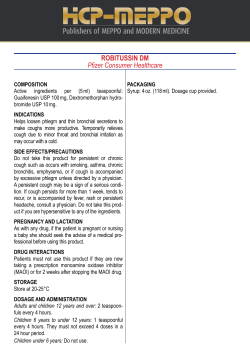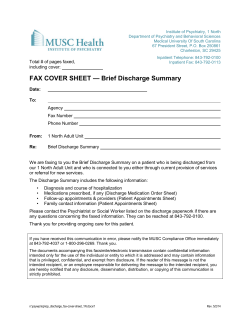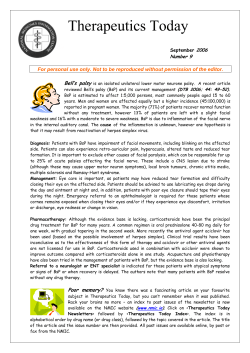
CPAX Poster Jnauary 2015 version 3
Can the Chelsea Critical Care Physical Assessment tool (CPAx), observed to predict hospital discharge location in the Chelsea and Westminster general adult critical care population, be similarly applied to the Oldham population? 52 patients were assessed who were discharged from Critical Care at Oldham between May 2014 and Jan 2015. Physiotherapists leading their care up to discharge were blind to their CPAx score. In 2012, Corner et al published a validated tool to measure physical morbidity in the general adult critical care population. In 2014 Corner et al followed this up with publishing a paper looking at the construct validity of the Chelsea Critical Care Physical Assessment tool (CPAx) analysing the association between CPAx scores and hospital discharge location, as a measure of functional outcome. They observed a clear association between CPAx score on discharge from critical care and place of discharge from hospital. (sample size 499 patients) Aspect of Physicality Level 0 Level 1 Level 2 Level 3 Level 4 Level 5 Respiratory Function Complete ventilator dependence. Mandatory breaths only. May be fully sedated/ paralysed. Ventilator dependence. Mandatory breaths with some spontaneous effort. Spontaneously breathing with continuous invasive or noninvasive ventilatory support. Spontaneously breathing with intermittent invasive or noninvasive ventilatory support Or continuous high flow oxygen (>15litres). Receiving standard oxygen therapy (<15 litres). Self-ventilating with no oxygen therapy. Cough Absent cough, may be fully sedated or paralysed. Cough stimulated on deep suctioning only. Weak ineffective voluntary cough, unable to clear independently e.g. requires deep suction. Weak, partially effective voluntary cough, sometimes able to clear secretions e.g. requires yanker suctioning. Effective cough, clearing secretions with airways clearance techniques. Consistent effective voluntary cough, clearing secretions independently. Moving Within the Bed e.g. rolling. Unable, maybe fully sedated/ paralysed. Independent in ≥3 seconds. Independent in <3 seconds. Unable/ Unstable. Initiates movement. Requires assistance 1 person (minimal). Independent in ≥3 seconds. Independent in <3 seconds. Dynamic Sitting (i.e. when sitting on the edge of the bed/unsupported sitting) Unable/ Unstable Initiates movement. Requires assistance≥1 person (moderate). Initiates movement. Requires assistance≥1 person (moderate). Requires assistance≥1 person (moderate). Initiates movement. Requires assistance 1 person (minimal). Supine to Sitting on the Edge of the Bed. Initiates movement. Requires assistance ≥ 2 people (maximal). Initiates movement. Requires assistance ≥ 2 people (maximal). Requires assistance ≥2 people (maximal). Requires assistance 1 person (minimal). Independent with some dynamic sitting balance, i.e. able to alter trunk position within base of support. Independent with full dynamic sitting balance, i.e. able to reach out of base of support. Standing Balance Unable/ unstable/ bedbound. Tilt table or similar Standing hoist or similar. Dependant on frame, crutches or similar. Independent without aides. Independent without aids and full dynamic standing balance, i.e. able to reach out of base of support. Sit to Stand (Starting position: ≤ 90 degrees hip flexion) Unable/ Unstable. Sit to stand with maximal assistance e.g. standing hoist or similar. Sit to stand with moderate assistance e.g. 1-2 people. Sit to stand with minimal assistance e.g. 1 person. Sit to stand independently pushing through arms of the chair. Sit to stand independently without upper limb involvement. Transferring from Bed to Chair. Unable/ Unstable. Full hoist. Standing hoist or similar. Pivot transfer (no stepping) with mobility aid or physical assistance. Stand and step transfer with mobility aid OR physical assistance. Independent transfer without equipment. Stepping Unable/ Unstable. Using a standing hoist, or similar. Using mobility aids AND assistance > 1 person (moderate). Using mobility aid AND assistance 1 person (minimal). Using mobility aid OR assistance 1 (minimal). Independent without aid. Grip Strength (predicted mean for age and gender on the strongest hand.) Unable to assess. < 20% < 40% < 60% < 80% ≥80% Table 1 Hospital discharge categories Survival Categories; 1.Home with no rehabilitation needs, considered the optimal outcome. No community services accessed. ≥39-50 2. Home with community support, this may vary from a full package of care to outpatient physiotherapy, Package of care, Integrated care team, Domiciliary therapy Outpatient therapy. 32-39/50 3. A short stay inpatient rehabilitation facility (< 6 weeks). An inpatient facility that had a maximum length of stay of 6 weeks. 25-32/50 4. A long stay rehabilitation facility (>6 weeks). An inpatient facility that had an expected length of stay of more than 6 weeks. 20-25/50 5. Nursing home level of care On-going daily nursing needs in a nursing home environment or home with a maximal care package, including a hospital bed and hoist transfers. 13-20/50 Non-survival categories: 1. Non-survival from ICU ≤ 3/50 2. Non-survival from hospital ≤ 22/50 Oldham Population (47 of 52 patients were included. 5 patients were discounted for incomplete data or who haven't yet left hospital) Survival Category and % patients who matched the predicted outcome; 1. ≥ 39-50/50—100% with this score achieved this outcome (5/5) 2. 32-39/50—50% with this score achieved this outcome. (1 of 2 went to IMC) 3. 25-32—73% with this core achieved this outcome. (3 died and 1 needed long term rehab) 4. 20-25/50—100% with this score achieved this outcome (2/2) 5. 13-20—0% with this score achieved this outcome (3/3 died) 6. ≤22—83% with this score did not survive hospital (1/8 went home with community physio) 7. ≤3—91% with this score died on ICU (1/3 went to long term rehab) Discussion This poster set out to test the observation that the CPAX score on d/c from Critical care can be used to predict place of discharge from hospital in the Oldham general adult critical care population. In 5 out of 7 categories it matched the Chelsea and Westminster population by over 70%. In categories 2,3 and 5, (50%, 17% and 100%), of those that did not match the outcome, outcomes were worse than predicted. In categories 6 and 7, of those that did not match the outcome, (17% and 8%), outcomes were better. Overall 71% of the population matched their outcome to the score and as such shows that the Oldham population is close enough to the Chelsea and Westminster population to allow the CPAx score to be used to predict place of d/c. The lower scores have a higher % prediction for non survival from hospital. Author; Rebecca Chadwick, Clinical Specialist Physiotherapist Respiratory and Critical Care, with thanks to Katy Howson. Intensive Care Unit The Royal Oldham Hospital, The Pennine Acute Hospitals NHS Trust.
© Copyright 2025















